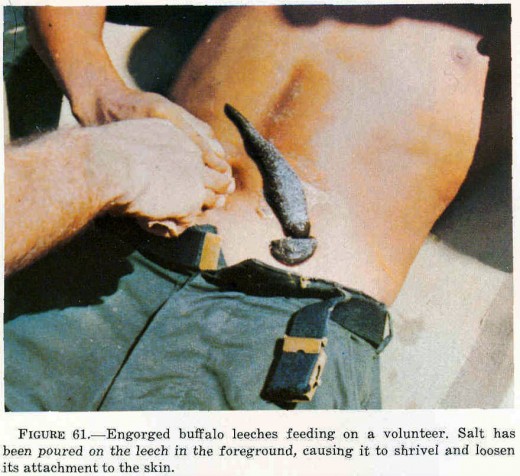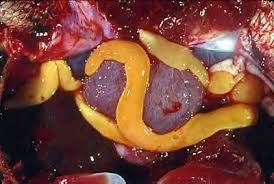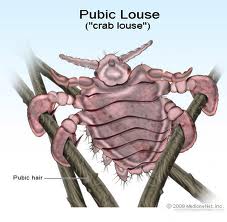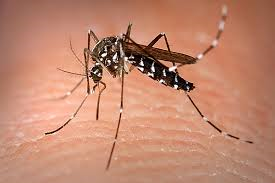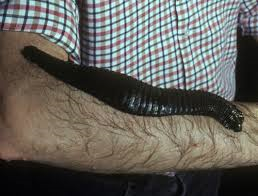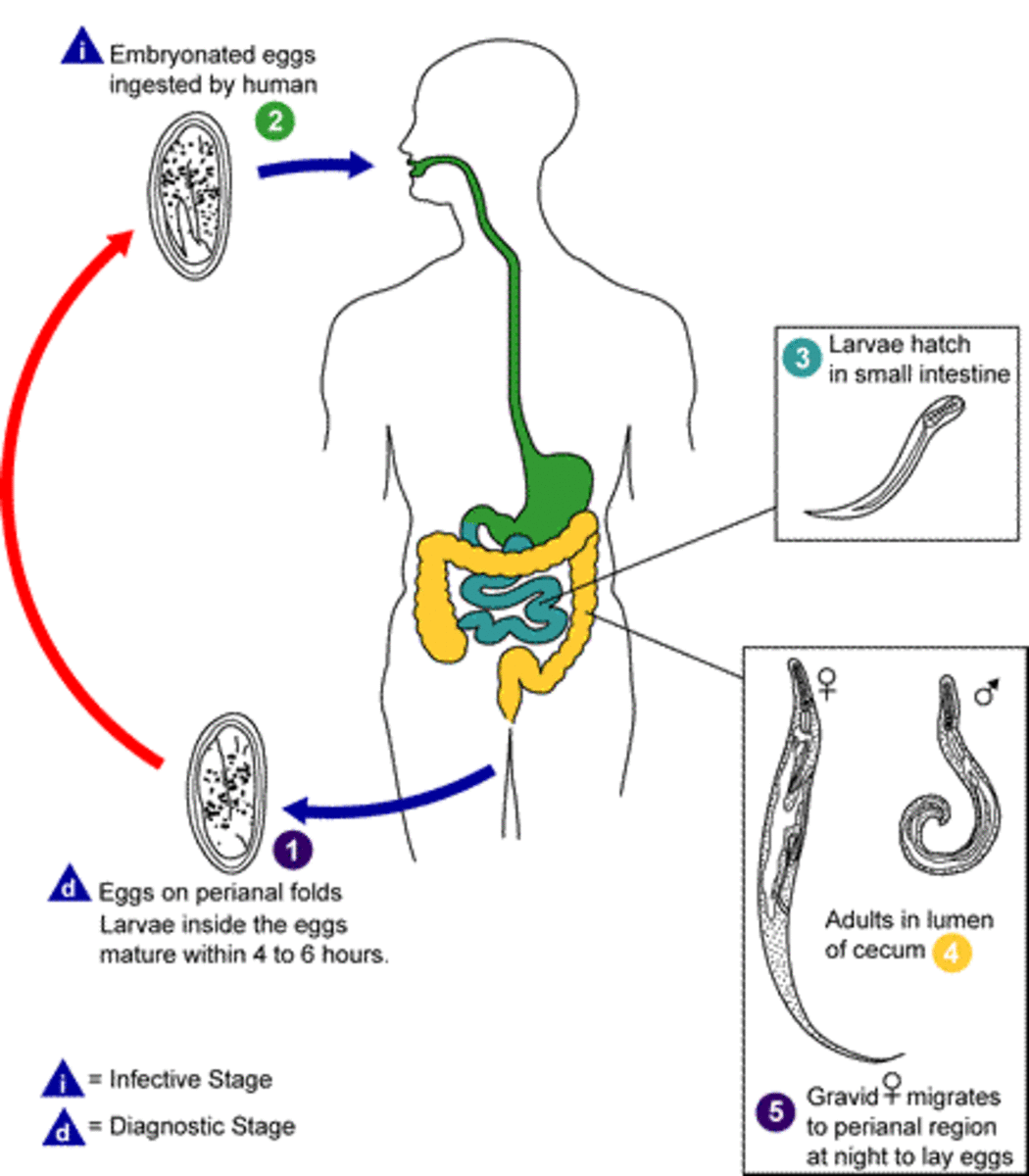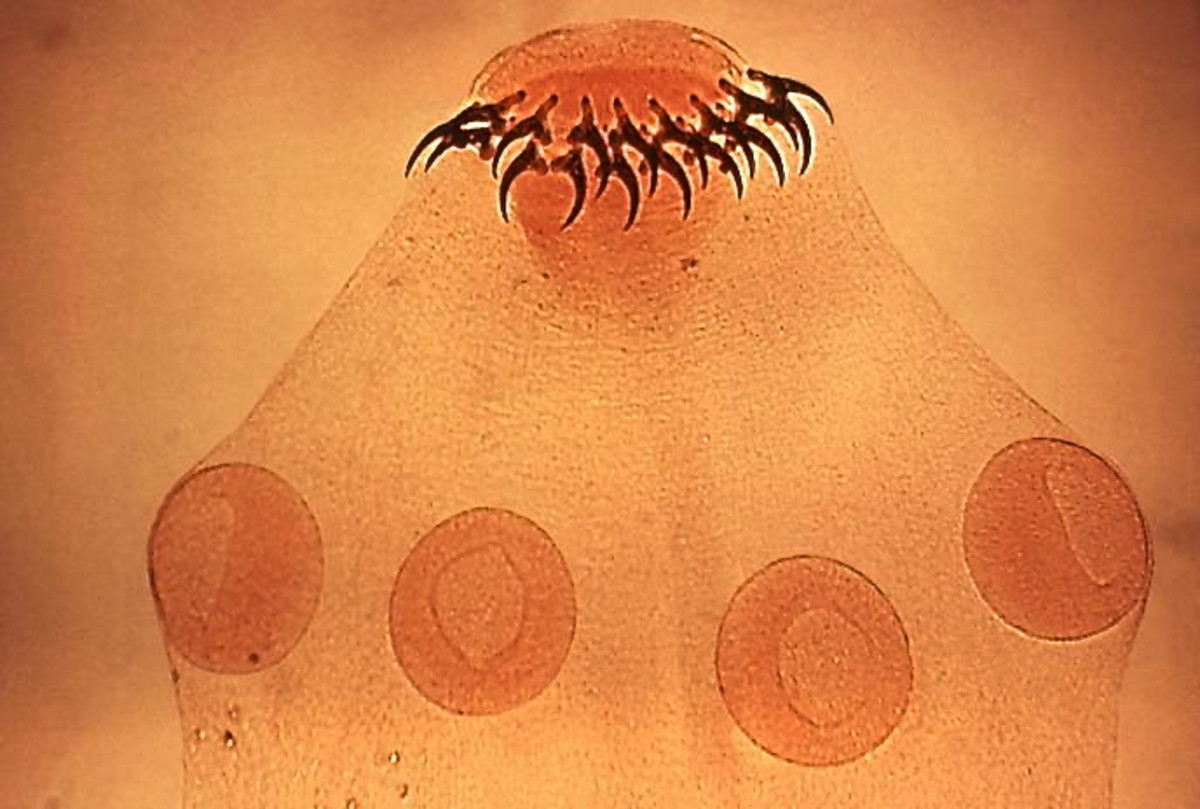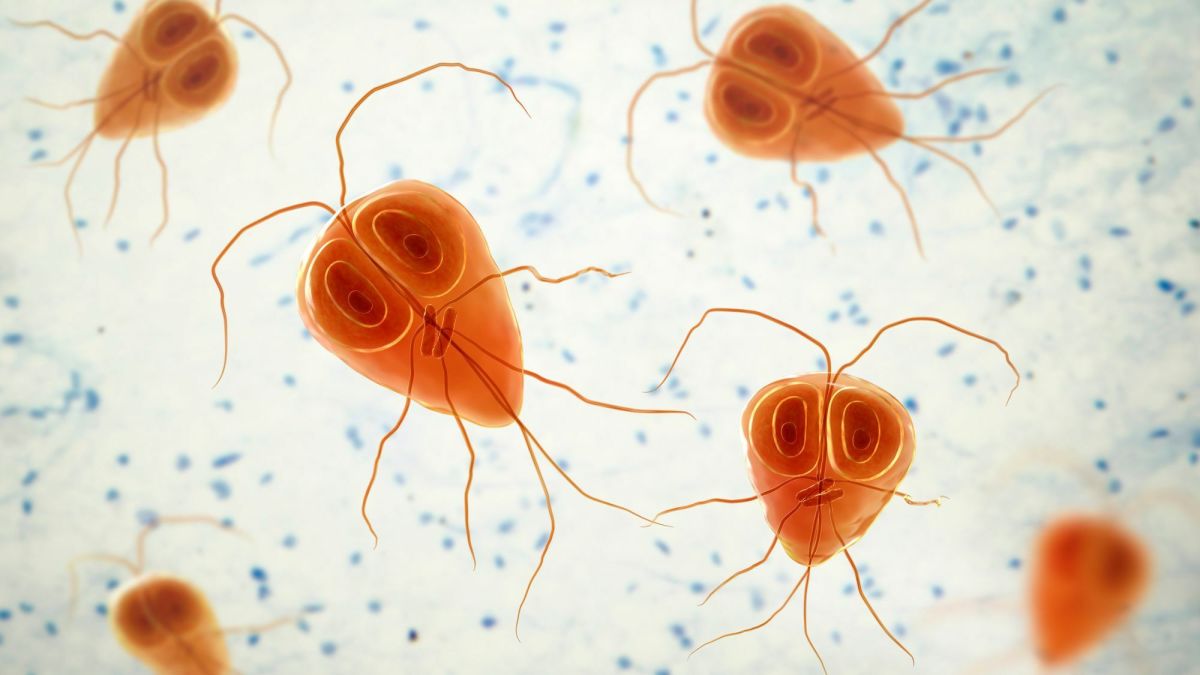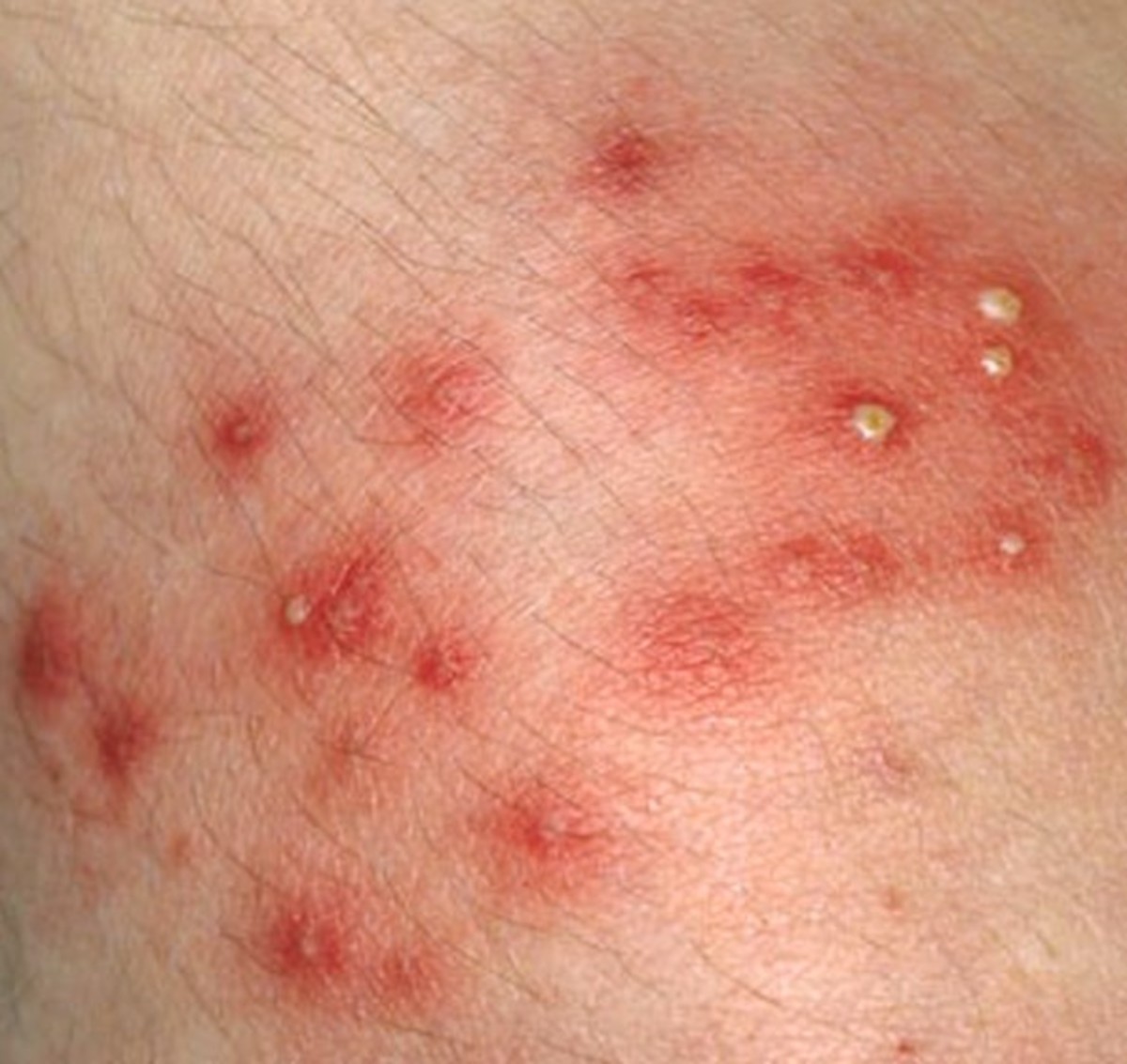Parasites: Are we meant to have them?
The secret life of Parasites is fascinating
Click thumbnail to view full-size





Parasites, Perhaps Evolution Means Us to have 'Em?
Moving on from bacteria and viruses which permantly occupy the human body, we are made aware of larger parasites which make a temporary home inside us.
Tape Worms, for example, which are no longer the menace they were back in the day due to our more hygenic habits and drugs which allow us to easily eliminate them.
The life cycle of these parasites is one of cattle to humans, as they eat infected grass, then we eat the infected meat and pass the mature worm segments back into the bovine environment.
The flat, whitish colored parasite grows in our digestive tract and can reach lengths of several meters! The segments then break off and are passed in our feces - or-make their own escape through the anus - carrying eggs which can infect grazing areas again. Not so easily as when we were hunter gathers or agrarian dwellers who used to do our number two's right there on the ground. In fact, tape worm infestation is quite rare in the first world today but still quite common in poor countries.
The tape worms are actually harmless to their hosts and, apart from making you hungrier, you could live without knowing you were carrying several feet of wriggling parasite inside you for years.
(My grandad who was a doctor up to 50 years ago in England said he operated on a women who had a 10-pound tape-worm inside her! The poor woman had been complaining for years she had "Sommat wigglin' in there, doctor," and had been told it was just gas and to take liver salts!)
Other parasitic worms are not always so friendly, like the Hook Worms and Round Worms, often infecting vital organs like the liver and even the brain.
Unfortunately, your (or my) ancestors in Africa had the nasty habit of having intercourse with Gorillas. This was the origin (many scientists believe) of man becoming a host to Crab Lice. Also far less common in today's world where the annoyance and shame of catching "Crabs" in the pubic area has paled into insignificance against the real life-threatening epidemic of AIDS. But when I was a teen-age sailor-boy, it was both and honor and a shame to line up at the sick-bay door to get a painting of "Blue Unction" around the genitals to rid ourselves of the nasty and itchy little critturs making merry around our nuts, meanwhile feasting on blood and derritus. They could only be caught in my situation with prostitutes in Malta's "Gut" area.
School kids in Britain in the last century were visited regularly during the school year by the "District Nurse," in the days before the NHS, to be examined for Head-Lice. These tiny little beasties were very infectious, leaping from lad to lad until the whole school was scratching and shameful. Again, an easy treatment eliminated most of the parasites.
Head Lice infection is rare today in Britain, but common in countries like Mexico where it is the parents who bear the burden of treatment.
Other lice, such as Body Lice which evolved from the head lice were also more of a problem in earlier times.
One of the most deadly parasite on the planet based on the amount of infections and deaths is the Malaria pathogen, the Plasmodium Malaria. This disease often leaves victims serving as hosts all their lives and actually kills half-a-milion people each year. (Note: Plasmodium is carried by several of the Anopheles Mosquito, not the Aedes variety seen in the photo...they do carry other diseases such as Yellow Fever, etc.).
The parasites work in same way as do certain virus. They invade the red blood cells, killing the cell and exploding into the surrounding tissue and blood, infecting other cells and tainting the blood with the derritus of the smashed cell structure, sometimes to the extent small veins and arteries can be completely blocked.
Malaria is carried by mosquitos, or course, and the pathogen also has the ability to sharpen the female mozzie's ability to smell human targets and home in for her blood meal.
Animals are subject to smart parasitical attack, too. Can anything be more horrifying or fascinating than observing a snail infected by Flatworm? The parasite gets into a snail's eye, causing it to swell and pulsate, attracting the attention of predators like the thrush or blackbird which swoops to devour the snail after smashing the shell on a handy rock. The bird is then infected by the flatworm which completes the rest of its life-cycle while joy-riding around the hedgerows.
Or the Toxoplasma Gondii which helps cats catch mice by slowing their reactions and causing rodents to find cat urine attractive to them as the moggie waits ready to pounce.
The cat - and also us - are then soon infected to the extent that perhaps 10 million British people are carrying the parasite!!
Scientists are finding, to their amazement and chagrin, that the parasites may be affecting our very behaviour by possibly slowing our reactions and perhaps contributing to situations like traffic accidents. We don't have the direct evidence of just how and how much we are in danger yet, but the rumblings from the scientific community are ominous and we remain a nation of cat-lovers.
Man has had a love-hate for many hundreds of years with Leeches. "Ugghhhhh" we shudder as we become temporary smokers and burn them off our legs in marshy areas. But they have also been used to remove bruised blood that has pooled in the body by the action of "peristalsis," sucking. A leech can engorge itself to more than 10 times its normal body size and weight with a blood meal. It also employs anti-clotting at the wound site to allow the blood to flow freely, using complex proteins also being studied. To cater to the medical need, several "Leech Farms" have been put in place; the tanks containg a marshy environment and thousands of leeches. Not a place you would want to take a cooling paddle! The leeches we are familiar with are small parasites, a matter of a couple of inches in length, but there is one terrifying species, the Buffalo Leech, which grows to more than a foot in length and can injest a gallon of blood! Why haven't our crime writers got onto that one!? "When we found her, Lieutenant, she had a hole in the throat and was sucked dry of all her blood!"
We might well ask "How do all these invaders beat our immune systems?" The answer, or course, is that in most cases they don't, but our intelligent "silent army" realizes to go into full combat mode with a moderately benign intruder might cause such a fever and other symptoms, the fight itself might make us seriously ill or even kill us.
One serious factor many doctors are noting is that allergies involving the immune system are on the increase as we have become richer and more hygenic. It seems that we are possibly so aclimatized over the millenia to living with some parasites, they had become actually beneficial to us and help us stave off other ills.
In any event, medicine is now quite involved in addressing this interesting area and we should watch our medical news for more on this.
This is just a glimpse into the world of parasites occupying humans...there are many more, including Flukes and Fungi, etc., etc.

